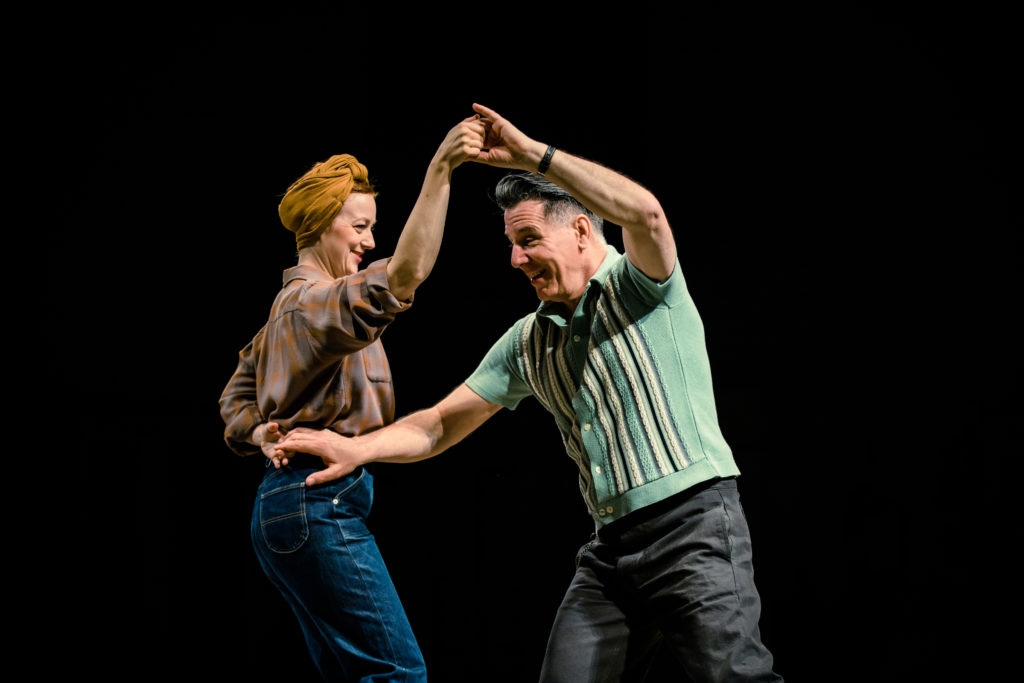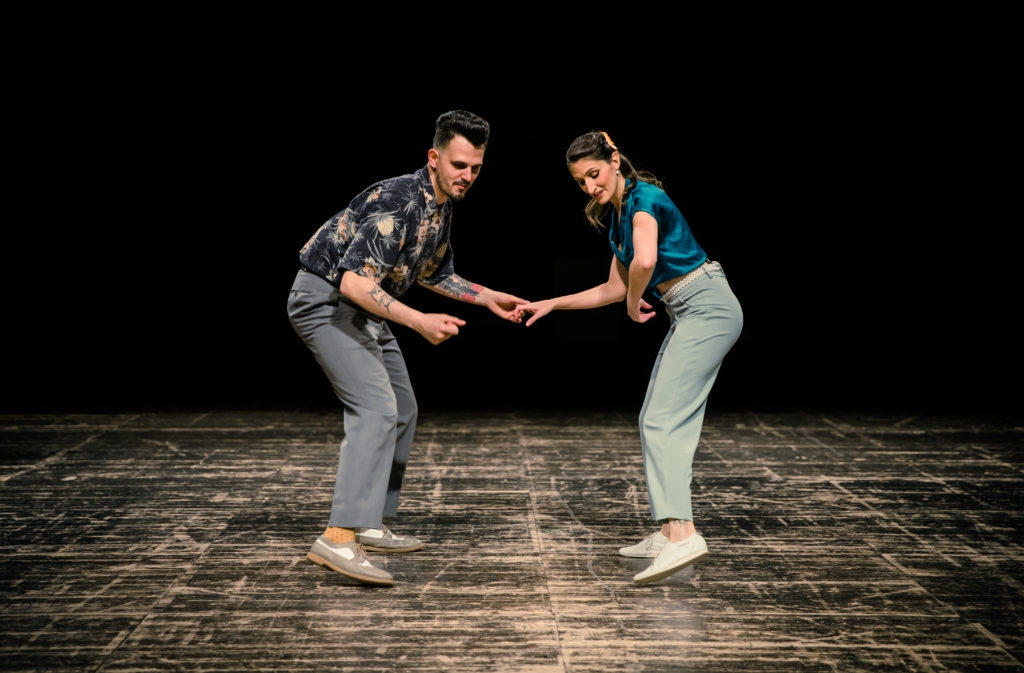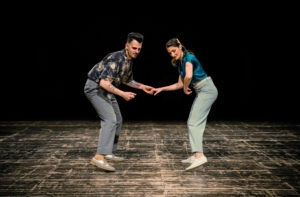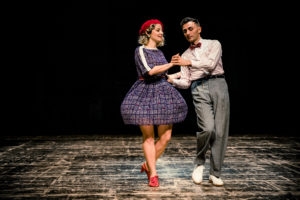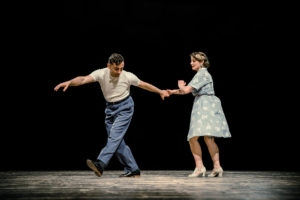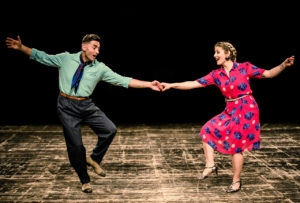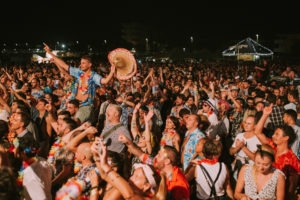The fabulous 1950s represent a real watershed in the history of dance: the dances of the decade were fun and innovative and reflected the evolution of the times.
The spread of television allowed millions of viewers to see their favorite songs performed for the very first time, and consequently also pick-up the dance steps that accompanied them.
It is precisely for this reason that certain dances acquired an unprecedented popularity, dances such as Rock’n’Roll (a teenage evolution of the Jitterbug and Swing dancing), the Madison, the Stroll, and the Hand Jive.
Here is an overview of the most popular music and 1950s dance styles.
1950s Music for dancing
The 1950s represented an exciting period for music, and consequently music for dancing was rich and manifold and provided a diverse soundtrack for the most popular dances of the decade.
Musical styles evolved rapidly with the birth of Rock‘n’Roll, and inevitably dance styles developed and varied to adapt to the changes in the music. The presence of a TV set in every family home also provided young people with the opportunity to learn new dance styles very quickly.
- Swing
Swing became popular and achieved commercial success at the end of the 1920s as a somewhat diluted evolution of Jazz. It experienced its height of popularity in the 1930s and 1940s (suitably referred to as ‘The Swing Era’) with the rise of Big Band Dance Orchestras, led by and featuring both black and white musicians.
In the 1950s however, the popularity of Big Bands and Swing music declined, and while some Big Bands continued to find work as studio orchestras for TV or radio productions, essentially they became the backing bands to a new (and considerably less swinging) ‘Pop’ sound. Vocalists took centre stage and singers such as Frank Sinatra, Dean Martin, and Judy Garland stepped into the spotlight.
- Jazz
In New Orleans at the end of the 19th Century, ‘Founding Father’ Buddy Bolden alongside fellow Afro-American musicians fused together ragtime, blues and gospel sounds and improvised rhythms during performances to create a brand new genre of music – Jazz. Jazz has remained popular in its various guises and evolutions for well over a century.
Throughout the 1920s, 1930s and 1940s it inspired many new styles and genres including Swing and Bebop, and at the beginning of the 1950s Jazz entered its ‘Cool’ phase. The music was calmer, more loungey, and featured softer and longer melodies. By the end of the decade however, some musicians began to reject the traditional norms and structures of Jazz in favour of an improvisational and experimental ‘free-jazz’ style (which would later become known as Avant Garde Jazz). Lester Young, Charlie Parker, Dizzy Gillespie, Miles Davis, John Coltrane, and Nina Simone were some of the most popular Jazz artists of the 1950s.
- Blues
Blues is thought to have originated in the Southern States of America after the American Civil War, however like Jazz, it wasn’t really documented until the turn of the 20th century. Also like Jazz, its roots are thoroughly African-American. This lyrical yet melancholic genre of music inspired many different styles from Delta Blues to Country Blues to West Coast Blues.
In the 1950s the Blues infiltrated the ‘mainstream’. The mass migration of African-Americans after the end of World War II and a general nationwide increase in income helped the Blues travel out of rural areas and into cities like Chicago and Memphis. Some styles favored the harmonica (blues harp), and others the electric guitar (electric blues), and some styles got labeled as ‘Rhythm & Blues’. Iconic artists of the decade included the likes of Muddy Waters, B.B. King, John Lee Hooker, Chuck Berry, T-Bone Walker, Howlin’ Wolf, Willie Dixon, Jimmy Reed and Bo Diddley.
- Rock’n’Roll
Rock’n’Roll was essentially an amalgamation of several musical genres: primarily Blues, Country and Bluegrass, and also Jazz and Gospel. Thanks to artists like Chuck Berry, Little Richard, Jerry Lee Lewis and the King of Rock’n’Roll himself, Elvis Presley, the genre had an immediate impact on the lives of its listeners.
Rock’n’Roll in the 1950s (and indeed today) was not just a musical genre, it was a lifestyle and represented a new way of looking at the world. It affected families, it influenced behaviour, language, politics, inspired fashion, and even influenced the Civil Rights movement. It’s rhythm and format is distinct and yet at the same time distinctly indefinable, thanks to its rich and manifold nature. Rock’n’Roll was a musical revolution that rocked the nation, literally.
- Rockabilly
Rockabilly is a musical genre that developed around the beginning of the 1950s in the southern United States. Its name blends ‘Rock’n’Roll’ and ‘hillbilly’, and the style of music is often categorized as a sub-genre of Rock’n’Roll with heavy Country music influences and links to Bluegrass, Jazz, Boogie Woogie and Rhythm’n’Blues.
The early recordings of Elvis Presley alongside many of the ‘Sun’ artists in the early 1950s were considered to be ‘Rockabilly’. The bands were small and usually limited to a couple of guitars and a double bass, accompanied of course by vocals. The recordings were rough and ready and the vocals often added that Country twang. Unlike Rock’n’Roll and Swing however, Rockabilly featured predominantly white artists such as Carl Perkins, Johnny Cash, Sonny Burgess and Jerry Lee Lewis.
- Caribbean Craze
It would be remiss not to mention the Latin American music craze that hit the 1950s hard with Mambo, Cha Cha Cha, Rumba, and Calypso rhythms infiltrating the airwaves and even diffusing into the Rock’n’Roll and Pop music of the day. The lively Cuban rhythms and rich musical sounds made for great dance steps and popular artists included Pérez Prado, Tito Puente, Xavier Cugat and Tito Rodrìgues.
The most famous and popular 1950s dance styles
The world of 1950s dance reflected the evolution of the times: they were innovative, enthusiastic, and fun, just like the 1950s.
Partner Dances
Rock’n’Roll
Rock’n’Roll is pretty much a blanket term for all of the dances that were danced to rock’n’roll music in the 1950s. The terminology can be confusing, as there were so many dance variations from State to State, and even from ballroom to ballroom, and on top of that, modern usage of some dance terms have a whole different meaning altogether today. So while it’s understandable that definitions of the dances will vary, it can be said that the Swing dances of previous years undeniably developed and evolved to the new rhythms and powerful beats of Rock’n’Roll during this revolutionary decade.
Jitterbug (also known as Jive)
The term Jitterbug dates from the 1930s, and referred to both the dancer and the dance. However it is generally agreed that the dance was a simplified version of the Lindy Hop, featuring fewer steps, and therefore making it easier to dance to faster music. As a dance it transitioned very easily from Swing to Rock’n’Roll music, and films such as Rock Around The Clock and Rock, Rock, Rock showcased the dance to a new generation of younger dancers eager to get on the floor.
Boogie Woogie
Boogie Woogie music was particularly popular in the 1920s, however the dance originated and flourished in the 1950s in direct response to Rock’n’Roll music. Like the Jitterbug, it has its roots in Swing, and is another off-shoot of the Lindy Hop. While it is certainly adept to Boogie Woogie piano rhythms, it is also associated (although not exclusively) with energetic, driving up-tempo rocking tunes. In the 1950s this dance variation would probably just have been known as ‘Rock’n’Roll’, however what we call Boogie Woogie today is also sometimes referred to as East Coast Swing.
Learn to dance in “vintage style”, take a look at our Dance Academy. Start from scratch or rekindle an existing passion for dance with our internationally renowned teachers.
Calypso
As America went gaga for the exotic rhythms of the Caribbean in the 1950s, it goes without saying that interest in dances such as the Mambo, Rumba and Cha Cha Cha also increased. The ‘Chalypso’ is the name that the iconic broadcast American Bandstand gave to the simplified version of the Cha Cha Cha that was becoming popular amongst teenagers. It remained a partner dance, but was very simple and playful, and the steps were performed out of hold.
Novelty Dances
Bunny Hop
The Bunny Hop was a classic early 1950s party dance: it was energetic and full of jumps, but very simple and repetitive, which made it perfect for parties. Dancers formed a line (imagine a conga line) and performed a short sequence of side-steps and jumps forward and back to the music. The dance routine featured on TV and even had its own song, with some versions including the instructions for the dance.
Hand Jive
In 1957 filmmaker Ken Russell recorded teenagers dancing the ‘Hand Jive’ in the basement of a London coffee bar. The venue was so crowded that there wasn’t enough room to actually dance properly, so they invented a rhythmic clapping choreography for their hands instead, which they could do without a partner and sitting down. It didn’t take long for the craze to reach the States and just one year later in 1958 American artist Johnny Otis had even recorded a song entitled ‘Willie and the Hand Jive’ with a notably recognisable Bo-Diddley riff.
Twist
Yet another novelty dance sensation in the 1950s was the Twist. Interestingly enough, just like the Hand Jive, songs were written in reaction to the dance craze that was inspired by and danced to Rock’n’Roll music, and not the other way round. In 1959 both Hank Ballard and Chubby Checker released tracks entitled ‘The Twist’ after the dance had already caught on. The dance itself is very simple; it is performed alone (without a partner) and is based on the swiveling motion of the hips and ankles that have the effect of ‘grinding’ into the floor. The torso has limited movement and the arms mimic the swiveling action of the hips.
Group dances in 1950s
With the decline of Swing and Big Band Orchestras, dance halls in the 1950s experienced a moment of crisis. However American teenagers still loved to dance, and towards the end of the decade group dances experienced a wave of popularity (thanks in part to their appearances on television). It was something new and different from the more established partner dances, and they were generally simple and easy to learn, which made them perfect for younger dancers.
The Stroll
The original Stroll emerged in the late 1950s and consisted of a line of women facing a line of men, forming a passageway down which couples ‘strolled’ to the music before parting and joining the end of their respective lines again. American Bandstand broadcast the dance being performed to the song of the same name by the group The Diamonds in 1957 and the rest, as they say, is history. The Stroll is still danced at events today but with significant variations from the original.
The Madison
The Madison emerged as a ‘line dance’ in the late 1950s in Ohio. It is danced without a partner, in lines on the dance floor, and follows a set choreography of steps and moves. In 1959 Ray Bryant released ‘It’s Madison Time’ in which the steps are called, and today the dance is commonly associated with this song. Like the ‘Twist’ and the ‘Hully Gully’, the dance went on to experience an even higher level of success in the 1960s after its appearance on television.
Hully Gully
The exact origins of the Hully Gully are unclear. History suggests that a dance called the Hully Gully dates as far back as the 1920s, however the dance referred to here is an ‘unstructured’ group dance that is commonly believed to date from 1959. This coincides with the release of the song ‘(Baby,) Hully Gully’ by the Olympics that vaguely described the actions of the dance that include ‘shaking’ the shoulders and ‘wiggling’ the knees.
In Conclusion
The music and 1950s dance styles are not just a thing of the past.
Rock’n’Roll is alive and kicking, and thanks to the millions of people all around the world that are captivated by the rhythms, dances, fashions, and living history of that incredible and world-changing decade, the music and 1950s dance styles are more alive today than ever.
It is a chapter of history that remains open, and continues to give joy at dance events all around the world.
Learn to dance in “vintage style”, take a look at our Dance Academy. Start from scratch or rekindle an existing passion for dance with our internationally renowned teachers.

